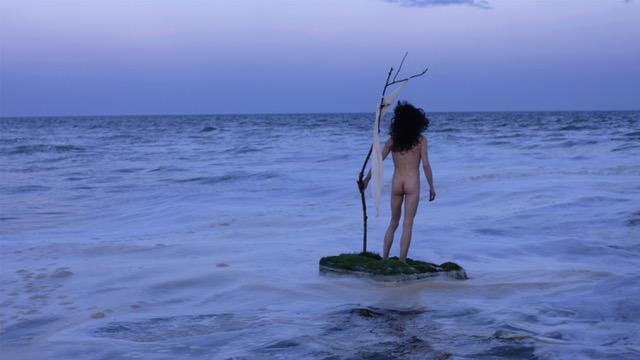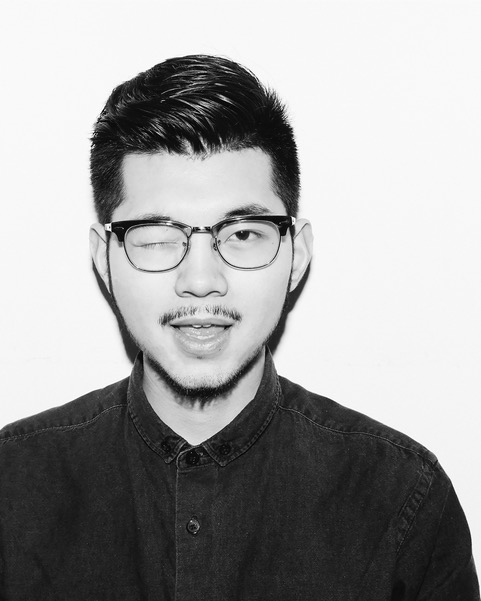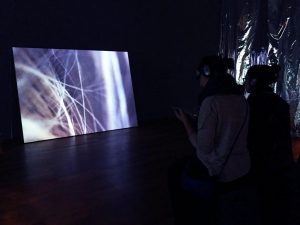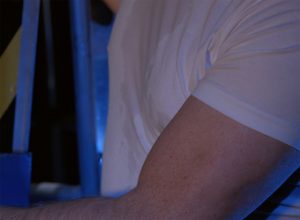Yao Cong’s immersive works retranslate human feelings
By James Brewer
A Chinese artist working in London, Yao Cong produces innovative video work challenging viewers to rethink gender, fantasies, and the power of demonisation and cliché.
He has again shown his flair as a maker of eerily emotive pieces with his latest, Uncertain Game. This is a 17-minute video and sound installation which follows an individual on a journey – “one that sets out to fuel a primal desire but then transforms into a complicated moral and spiritual examination of humanity,” as Cong describes it.
With already acclaimed work in Europe and his native country, Cong has been making his mark in London for two years, as he secured his MA degree. It was the first time he has studied overseas – which brought “many challenges.”
He was born in Xi’an, the ancient capital which has been called one of the birthplaces of Chinese civilisation. The metropolis is the eastern terminus of the Silk Road and the home of the fabulous Terracotta Warriors of the Qin Dynasty.
The overwhelming impression from his output is that it is intensely frank and at the same time gentle. In muted tones, it borders on abstraction, without locating specific time or place.
In Uncertain Game, a mysterious ‘game’ takes place inside a car; strange figures appear by a lake; eventually a lone person on an abandoned diving platform looks up at what appears to be another figure swimming in suspended water, then at another figure floating on an unknown island. The images wander in the imagination of the protagonist and consciously or unconsciously connect to form an uncertain boundary.
This kind of “in between” state questions how we present our bodies and escape determinism, says Yao Cong. It also reconfigures the language of desire, anxiety and authority into a fluid, hybrid structure, says the author. As if to emphasise the emotional conflict and the struggle to resolve it, the video ends with the strains of the ballad Crying, a hit for Roy Orbison in 1962. The reason for this is because the rhythm of the song evokes a snare drum, or bolero music. It could be a symbol of dominance and repetition, with the attractiveness of the rhythm contrasting with the lyrics speaking of isolation and sadness.
It amounts to an account of deconstruction and convergence which posits a search for underlying meaning.
Stylistically, as in some of his earlier essays, the fragmented body, body movement, colour and textures appear between the real and surreal, but attention to those colours and textures is rewarded, even as we still grasp after the context.
Restructuring self-perception and retranslating human feelings, Cong is creating immersive works with hazy and poetic aesthetics. In these narratives, he says that he brings “a lot thinking and experiences from Chinese culture about the queer community.”
He explains: “I come from a northern city, Xi’an, with a very open history, now full of tradition; but I have been mainly living in the southern city of Hangzhou, as my personal ideology matured. These two cities with a similar long history, turned to a different ideology during the recent economic transition. They are both in China, they have their own characteristics, but also in common the political environment.
“China is without equal, and it is impossible to generalise – Chinese history is too long to trace the sources of certain phenomena. However, my experience in these two places is the origin of my ideology and artform development, as I study how it shapes the environment.”
On the question of homosexuality, “China has a long, unique and tepid history.” There was no record of widespread violence towards gays, and there was a ‘queer atmosphere’ full of social culture.
“Social change in different eras re-created the ideology of people, but historical origins meant such an atmosphere was there to stay.” There was a “repressed neglect” in which euphemism and self-healing confession became the pillar of the queer community, an increasingly underground and suppressed activity. There was “sometimes even a little bit of so-called progress and openness, all with a deep shadow of the hegemony of heterosexual.
“The word ‘homosexuality’ is still unfamiliar to most people in China, especially the generation before that of our parents, and therefore there is an attitude of ‘you know and I know, it is OK, do not expose.’
“This is the way of dealing with the queer issue in most of society. There is a strong relationship link with localisation and globalisation, together what some people call ‘glocalisation.’
“My upbringing in China gradually brought out my strong cultural brand of myself, so the metaphor of covering up, monologue, self-healing, isolation, with the particular texture of traditional oriental literati gradually emerged in my evolution. I declare the power of internalisation in a quiet way. This is my dialogue with myself, but also the journey of finding myself.”
He adds: “Everyone seeks to build their own set of theoretical bases, as well as ideology, to achieve their own burning role of self-justification. In the ideal of glocalisation, I need to keep running, constantly questioning, insisting on the creation of passion, trying to translate the real self, to move forward.
“I continue to deal with the art issue in a substantial way. Art is a tool, I use it because I need it.”
Cong’s artistic language began to emerge early. “My mother told me that when I was very young, maybe around four years old, I liked to draw on the wall, and to stand in the spotlight to recite poetry and dance.” This enthusiasm for artistic performance was to flourish “during my long foundation period of study.”
His father had been obsessed with photography when young, and as a girl, his mother was a musician in an art troupe. Cong says: “From an early age I always felt that I had an inexplicable sensitivity and fascination for colour and rhythm. It sounds like a cliché, but this has been a real manifestation and memory.
“From drawing on the wall, and later drawing pictures in a book every day after school (I don’t know why I did that, maybe just because I loved it!) then slowly as I grew up I began using a video camera to record each outing, and would go home to sort out the photos or produce homemade DVDs.”
In 2015, he began a two-year MA course in Moving Image and Contemporary Art Practice at the Royal College of Art in London. The course was intense, evincing a feeling like “the kind of pleasure that comes from trying to re-analyse your whole physical and psychological being in one brief period. I enjoy that feeling, even though you know it is complicated, a mixture of pain and pleasure.”
He found the RCA an excellent platform for meeting many talented artists and reviewing his own practice over and over.
London almost “gave me too much,” and he says that was maybe because of his perception that social environment is always a more powerful impulse than an independent institution, even a renowned college.
The capital offered a bigger perspective and the atmosphere to think: “The so-called freedom here, the so-called independence, the so-called success, and so on, led me constantly to think about the meaning of what is going on today and the possibilities of the Anthropocene [the most recent geological time of planet Earth], as values change and reality collides.
“In my two years at the RCA, I continued to try to break through the bottleneck, and adhere to the front line where the greatest harvest may be the passion for artistic creation unabated, as well as the enduring interest in reading. All these made me feel secure and fulfilled.
“Sometimes I question the situation of fine art education: people are more and more but cautiously following their own way, and that ‘own way’ sometimes becomes overblown. That is dangerous and false during an era when people are trying to reach the moral high ground, to be international with a eurocentrist background, to respect justice, to be open-minded. But in any event the RCA and London, all the experiences are precious, and I cannot forget them ever, nor should I.”
Before the RCA, he was for four years at China Academy of Art, where he won several awards.
He has been variously involved with moving image, physical theatre, installation and photography “in constant attempts and explorations.” He still experiments with all forms, based on the kind of medium or presentation that is more suitable for the moment.
“But of course, I am in awe of the tolerance of moving image; I am ever curious about the initiative and passive features during the process that informs the eyes by means of the camera to record and present the reality. At the same time, I like the process of making moving image works; and the inclusivity and plasticity of moving image for the body movement and rhythm that interests me; the visibility of the linear remodelling of moving image. All leads me to think there is so much I need to do.”
Cong has exhibited in many countries, so it is appropriate to ask how the contact with other arts scenes has influenced his approach and the content of his work.
“Exhibition is a very proper way to present the voice of artists and build a connection with real life, but it is a limited way to define what is art, what is art work, then try to explore and expand art with the artwork. So, it is already a kind of laboratory of possibility.
“I try to keep myself attending more exhibitions and art events, which can help ascertain my artistic ability. But I also try to build a connection with the art market and such circles, to know more excellent artists, and continue to improve the artistic exposure of myself, as well as the thinking and experience in the exhibition. It is a tangible way to push myself to be a more mature artist.”
Among the shows he found most refreshing was one earlier in 2017 in the Greek capital, where the very word Athens, with its weighty historical background seemed to be watching over the contemporary art. “Today the art market is so impetuous, that it is a kind of quiet progress to take a timely look back.”
Another big exhibition has been Videonale 16 at Kunstmuseum Bonn from February-April 2017. This is one of Europe’s oldest video art festivals, and one of the most prestigious biennials of its kind. As a young independent artist, he felt excited to be among masters of the craft and to realise what his own possibilities could be.
An earlier work is The Soliloquy in the Air a video of just under ten and a half minutes. In this 2016 piece a repeated rhythm gradually becomes stronger, a repetition that infiltrates the perception of time. We see a man washing a machine. The act of labour is simple and thorough, yet the movements reveal an underlying meaning of desire. This behaviour becomes a game where man and machine negotiate for rights. There is a hunger and longing for freedom, but also the representation of weakness, a hidden anxiety, and truth.
Curated by Espronceda Centre for Art and Culture, Barcelona (where he has been an artist in residence) in cooperation with the Royal College of Art, Pleasure in Progress raised key issues when of gender, sexuality and the body in cultural representation and personal emotions. Yao Cong explores how to administer, or be administered by, the “pleasure” in human perception and life experience. This project questions the relationship between nature and civilisation, how humans try to find a poetic lifestyle, how humans learn to adapt themselves across political, social and cultural changes and how these factors influence human pleasure – and asks if it is possible to find a more authentic “pleasure” from the “pleasure of progress.”
Separately, in a six-minute video, Under Blue, the film-maker explores gender politics through beauty, pleasure, disgust, danger, violence, the erotic and the artificial, the dance of the artist’s brush and the movement of the camera, imparting to the viewer an uneasy feeling of voyeuristic power. The concept in Under Blue broadly speaking fits into performance and body art trends in video art, but the use exclusively of close-ups gives the effect of not really understanding what we are looking at.
A performance project begun in July 2013, Listen For, seeks to reflect something of the life experiences of Chinese gay men. It is a series of conversations with and photographs taken of men he arranged to meet in hotel rooms. As a listener, the artist wants both to probe memory and to play a passive role. As he talks, he recalls a variety of memories. “The truth of the matter is, despite the positive publicity toward Chinese gay men, and as a participant myself in the photos, I find it extremely difficult to continue the piece, but it also makes sense to keep the project going,” he comments.
Recently Cong has been combing through the record of his art creation, especially from his MA time: “I often think about what is the meaning of the end of the MA. I will continue to explore and examine the ongoing topic of sexuality and gender issues, and put my own experience into them, so this big topic itself has already become the mirror of the era and the track of my growth.”
Yong Cao’s website is www.yao-cong.com












